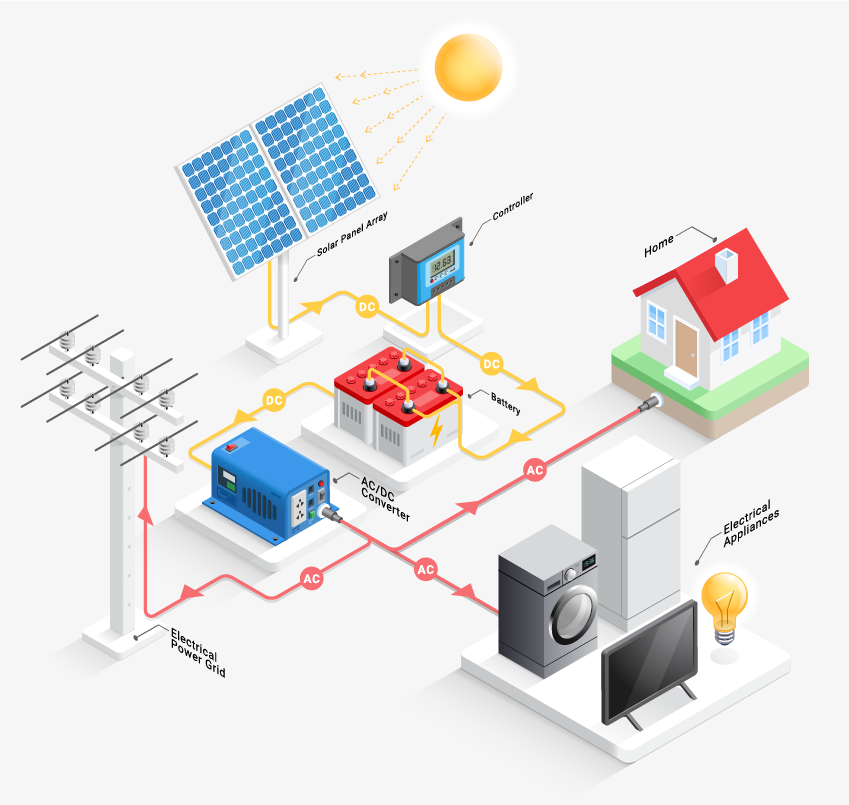Solar
Solar is currently the fastest growing power generation technology in the world. Here at MP Industries, we’re utilising solar power to harness nature’s resources and deliver clean, renewable power to our clients and partners.
Our sustainable approach to project development balances complex siting data with community needs to develop solar projects that exceed economic expectations, while earning the trust and support of local communities and landowners.


Solar panels can be placed both on the roof and walls of buildings and on the ground using special designs.
Depending on the location of the solar power plant, 1kWt of installed capacity is able to produce 950 - 1200kWth per year.
Inverters can work both in parallel with the network and in isolation from the network. When choosing the type of inverter, it is necessary to take into account the availability of the network as well as the technical conditions of the local power grid operator.
Our engineers will help you to design the best solution for your requirements.
A brief history of Solar Power
The development of solar energy goes back more than 100 years. In the early days, solar energy was used primarily for the production of steam which could then be used to drive machinery. But it wasn’t until the discovery of the “photovoltaic effect” by Edmond Becquerel that would allow the conversion of sunlight solar electric energy. Becquerel’s discovery then led to the invention in 1893 by Charles Fritts of the first genuine solar cell which was formed by coating sheets of selenium with a thin layer of gold. And from this humble beginning would arise the device we know today as the solar panel.
Russel Ohl, an American inventor on the payroll of Bell Laboratories, patented the world’s first silicon solar cell in 1941. Ohl’s invention led to the production of the first solar panel in 1954 by the same company. Solar panels found their first mainstream use in space satellites. For most people, the first solar panel in their life was probably embedded in their new calculator – circa the 1970s!
Solar panels collect clean renewable energy in the form of sunlight and convert that light into electricity which can then be used to provide power for electrical loads. Solar panels are comprised of several individual solar cells which are themselves composed of layers of silicon, phosphorous (which provides the negative charge), and boron (which provides the positive charge). Solar panels absorb the photons and in doing so initiate an electric current. The resulting energy generated from photons striking the surface of the solar panel allows electrons to be knocked out of their atomic orbits and released into the electric field generated by the solar cells which then pull these free electrons into a directional current. This entire process is known as the Photovoltaic Effect. An average home has more than enough roof area for the necessary number of solar panels to produce enough solar electricrity to supply all of its power needs excess electricity generated goes onto the main power grid, paying off in electricity use at night.
In a well-balanced grid-connected configuration, a solar array generates power during the day that is then used in the home at night. Net metering programs allow solar generator owners to get paid if their system produces more power than what is needed in the home. In off-grid solar applications, a battery bank, charge controller, and in most cases, an inverter are necessary components. The solar array sends direct current (DC) electricity through the charge controller to the battery bank. The power is then drawn from the battery bank to the inverter, which converts the DC current into alternating current (AC) that can be used for non-DC appliances. Assisted by an inverter, solar panel arrays can be sized to meet the most demanding electrical load requirements. The AC current can be used to power loads in homes or commercial buildings, recreational vehicles and boats, remote cabins, cottages, or homes, remote traffic controls, telecommunications equipment, oil and gas flow monitoring, RTU, SCADA, and much more.
Every project is Unique
At MP Industries, we strongly believe that every project is unique and should be treated as such. There are many ‘out of the box’ solutions but these don’t always fully suit the application. Our approach is different.
Get in touch with our team to discuss your requirements and begin the journey to your tailor-made solution.
Contact Us
Get in touch to discuss your requirements with our always helpful and friendly team.
